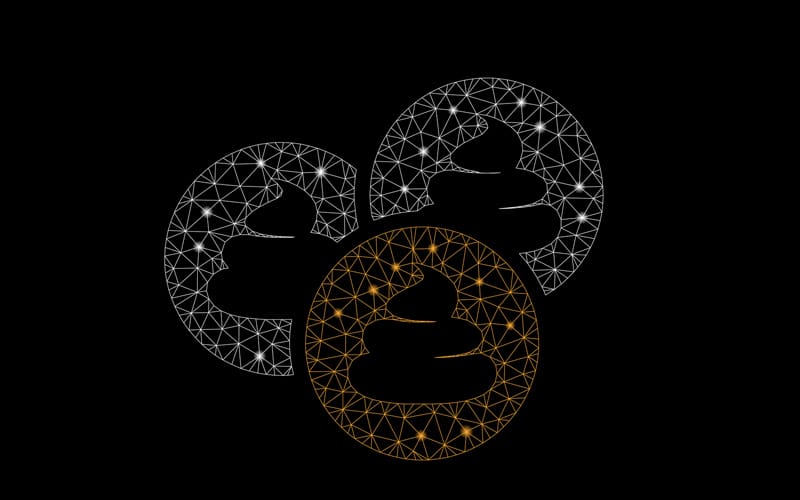
When Satoshi Nakamoto introduced Bitcoin back in 2009, cryptocurrencies were largely frowned upon at the time. However, in recent years, these digital coins have become the craze, and nobody wants to be left out of this movement – be it individuals, corporations, or even entire countries. With this inflated demand, several coins have been brought to market, some of which are outright scams or coins that have no purpose and thus hold no value. As of January 2022, there are over 8,000 cryptocurrencies in circulation.
Shitcoins explained
A shitcoin is a cryptocurrency that is failing or a spinoff of a coin that has already failed. Usually, these coins will have no defined purpose to justify their existence. Essentially, these coins exist just because they can. Since they are not backed by any fundamentals, they tend to have little to no longevity.
Since the classification of shitcoins is majorly opinion-based, some people will refer to most altcoins as shitcoins. A good example of one is Dogecoin. This is a coin that forked from Litecoin in 2013 and was created as a meme coin and named after the Shiba Inu dog breed. Though it has no discernible purpose, Doge was extensively marketed by renowned influencers such as Elon Musk, which drove its value up. However, as is common with most shitcoins, its value soon plummeted, and now, it hardly makes any significant movements.
How they work
Usually, the creators of a crypto coin will outline the total supply of their coin on their whitepaper. Bitcoin, for instance, has a total supply of 21 million BTC. ETH’s supply is also capped at 18 million coins per year.
With this number, investors know that the coin is deflationary in nature, and its value will only rise as demand rises over time, with no commensurate increase in supply. If the supply of such a coin were to be increased later, it would devalue the holdings of the coin’s investors.
Shitcoins have no purpose. As such, they cannot create genuine demand among investors. To obtain value, they rely on hype and influence from celebrities in the field, such as the aforementioned Dogecoin example.
Characteristics of shitcoins
At their launch, these coins will typically sell for throwaway prices. After several investors buy into it, the price will often spike high over short periods of time. However, these investors almost always sell their positions after this hike, which sends the coin’s price on a nosedive. This process is called pump and dump.
More often than not, shitcoins will have a low market cap. This allows a few investors to easily manipulate prices by making a few large trades.
As aforementioned, these coins will have no clearly defined purpose. Bitcoin and Ethereum were built to decentralize finance and facilitate intermediary-less transactions on their networks. BNB, the native coin of the Binance Chain, is purposed with reducing fees on the network and powering the blockchain. Shitcoins will have no such purpose.
These coins will also have a poorly executed whitepaper or website, which may sometimes be copied from other crypto projects. They will also have low liquidity, some going as low as $30,000. What’s more, the developers of such projects will likely remain anonymous. All these characteristics can be used to identify potential shitcoins before investing in them.
Popular shitcoins in the market today
1. Magic Internet Money (MIM)
According to CoinMarketCap, MIM is ranked as the 2825th largest coin by market cap. At the time of writing, its price is $1. This coin was meant to be a stablecoin that could be exchanged with other stablecoins in the market.
Other than its low market capitalization, MIM has a vague founding team, and it is not supported on most popular exchanges. What’s more, there are several other much more renowned stablecoins, which render the MIM coin irrelevant. All of these characteristics lead us to term it as a shitcoin.
2. SafeMoon
CoinMarketCap ranks SafeMoon 212th by market cap, with a capitalization of just below $1 billion. The coin was launched with the intention of using it as a decentralized finance token on the Binance Smart Chain network. It features reflection, liquidity pool, and burning functions on each transaction.
This coin was mostly hyped by celebrities like Logan Paul and Lil Yachty, who helped push its popular tagline – Safely to the moon. SafeMoon is also scheduled to launch an NFT marketplace as well as a coin launchpad where users can launch their own coins. However, the low liquidity it sees makes it a risky investment.
3. Dogelon Mars (ELON)
This coin started as a spin-off of Dogecoin, and like its predecessor, it was introduced as a joke currency. It was launched in April of 2021 when Dogecoin was enjoying the most hype. With a market cap of nearly $500 million, this coin ranks 122nd largest cryptocurrency.
4. Baby DogeCoin
As its nomenclature implies, this is another Dogecoin clone. Launched in June 2021, the coin saw a massive 1,000% spike just a fortnight after its launch. This spike was largely caused by tweets from Billionaire and DOGE influencer, Elon Musk. Baby DogeCoin claims to have faster transactions than Dogecoin.
5. Floki Inu
This is yet another of Elon Musk’s signature projects, as it is named after his pet dog, Floki. It is ranked at number 2866 by market cap. A few months after its launch, it saw significant price hikes thanks to Elon Musk’s influential tweets.
This shitcoin stands out from the rest because it is associated with various projects. It partnered with Garden Movements to combat food security under the leadership of Kimbal Musk, Elon’s brother. It also features an education platform called Floki Inuversity, NFT games, and a marketplace for merchandise.
Conclusion
Shitcoins are cryptocurrencies that are launched with no specific purpose. More often than not, they will be a spin-off from a failed or failing project that previously enjoyed popularity. They are characterized by low liquidity, vague founders, and a sub-par whitepaper.








Leave a Reply